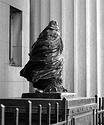removed account4
Subscriber
- Joined
- Jun 21, 2003
- Messages
- 29,832
- Format
- Hybrid
i have a kind of strange thing that happened over the weekend
i shot a bunch of tmy and tmx sheets
all at the same speed, so the tmy is 2 stops more exposed ..
they were all processed the same, in the same tank, with the same chemicals. ( it is old tmy, not the new stuff )
i printed them out onto ilford rc paper and used the same chemistry.
the tmx was 50 seconds
and the more dense tmy took 2 seconds to expose.
i even moved the light source up about 6 inches,
or my exposure time would have been even shorter
(i'm using a 300watt bulb )
anyone have any suggestions as to what might be going on ?
it makes absolutely no sense ( to me ) that a more-dense negative
would would take so much less time to expose.
thanks in advance for your expert opinions!
john
i shot a bunch of tmy and tmx sheets
all at the same speed, so the tmy is 2 stops more exposed ..
they were all processed the same, in the same tank, with the same chemicals. ( it is old tmy, not the new stuff )
i printed them out onto ilford rc paper and used the same chemistry.
the tmx was 50 seconds
and the more dense tmy took 2 seconds to expose.
i even moved the light source up about 6 inches,
or my exposure time would have been even shorter

(i'm using a 300watt bulb )
anyone have any suggestions as to what might be going on ?
it makes absolutely no sense ( to me ) that a more-dense negative
would would take so much less time to expose.
thanks in advance for your expert opinions!
john





 )
)
